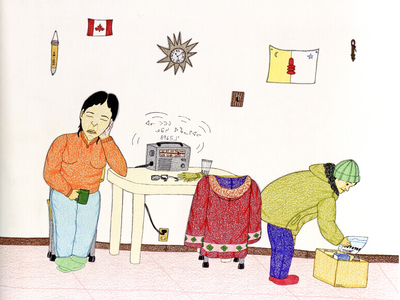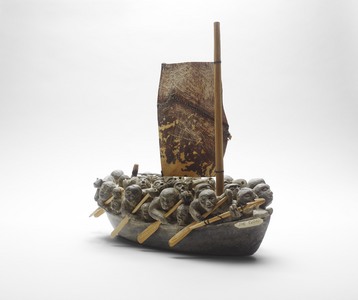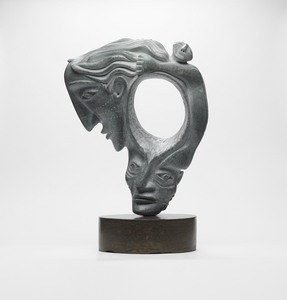
Annie Pootoogook Calling Annie, 2005–6 (pictured at top)
EYE WEEKLY - 03 / 30 / 2011
Northern Lights
A new AGO exhibition about modern Inuit masters explores a culture in transition.
—
When people think of Canada, they think of the Inuit,” says Gerald McMaster, curator of Canadian art at the Art Gallery of Ontario. And yet, while the word Inuit is no longer synonymous with igloos and snow, our idea of Inuit art is still tied to small stone sculptures of hunters throwing spears.
“Inuit Modern: The Samuel and Esther Sarick Collection”—opening at the AGO on April 2—challenges this view. Featuring more than 175 works by 75 artists, the exhibition explores how the Inuit have dealt with the complexities of globalization and climate change, and the impact of Southern Canada on their traditional way of life from the 1950s to the present. McMaster selected three masters of Inuit modernism and explained why their work stands out.
1. ANNIE POOTOOGOOK CALLING ANNIE, 2005–6
(PICTURED AT TOP)
Coloured pencil and ink on paper
“With Annie Pootoogook, we see nothing of the hunting, fishing and spirituality that’s come to be associated with Inuit art,” says McMaster. “Rather, it’s interior scenes: guys playing cards, women going to the fridge.”
In this drawing of the artist’s sparsely decorated kitchen, the radio blares out in Inuktitut characters, “Annie Pootoogook, the younger one, must call 8965.” This message illustrates the auto-biographical nature of her work. Born in Cape Dorset, Nunavut, the 41-year-old Pootoogook focuses on subjects that range from the prosaic (friends playing cards, people buying groceries) to the horrific (depictions of spousal abuse, alcoholism and mental illness). In 2006, Pootoogook won the prestigious $50,000 Sobey Art Award, given annually to an emerging Canadian artist under 40; in 2007, she participated in Documenta xii—the world’s most important contemporary art event, held once every five years in Kassel, Germany.
When people think of Canada, they think of the Inuit,” says Gerald McMaster, curator of Canadian art at the Art Gallery of Ontario. And yet, while the word Inuit is no longer synonymous with igloos and snow, our idea of Inuit art is still tied to small stone sculptures of hunters throwing spears.
“Inuit Modern: The Samuel and Esther Sarick Collection”—opening at the AGO on April 2—challenges this view. Featuring more than 175 works by 75 artists, the exhibition explores how the Inuit have dealt with the complexities of globalization and climate change, and the impact of Southern Canada on their traditional way of life from the 1950s to the present. McMaster selected three masters of Inuit modernism and explained why their work stands out.
1. ANNIE POOTOOGOOK CALLING ANNIE, 2005–6 (PICTURED AT TOP)
Coloured pencil and ink on paper
“With Annie Pootoogook, we see nothing of the hunting, fishing and spirituality that’s come to be associated with Inuit art,” says McMaster. “Rather, it’s interior scenes: guys playing cards, women going to the fridge.”
In this drawing of the artist’s sparsely decorated kitchen, the radio blares out in Inuktitut characters, “Annie Pootoogook, the younger one, must call 8965.” This message illustrates the auto-biographical nature of her work. Born in Cape Dorset, Nunavut, the 41-year-old Pootoogook focuses on subjects that range from the prosaic (friends playing cards, people buying groceries) to the horrific (depictions of spousal abuse, alcoholism and mental illness). In 2006, Pootoogook won the prestigious $50,000 Sobey Art Award, given annually to an emerging Canadian artist under 40; in 2007, she participated in Documenta xii—the world’s most important contemporary art event, held once every five years in Kassel, Germany.

Joe Talirunili, Migration, circa 1974
2. JOE TALIRUNILI, MIGRATION, CIRCA 1974
Tone, hide, wood, string
When Joe Talirunili (1893-1976) was a child, he and his family, along with about 40 other members of their community, were coming home from his baptism; they found themselves set adrift in Hudson Bay on an ice floe. As the ice that supported them gradually melted, Talirunili’s family and friends built a boat using seal skins and wood from their sleds. They drifted in that vessel for days before reaching land.
“This experience—the subject of Migration—became seminal to Talirunili’s work,” says McMaster. “Throughout his life he made many variations of this sculpture, which addresses the harshness of the climate and the strength of a people dependent on nature and community spirit for survival.” In 2006, one of Talirunili’s Migration sculptures sold for over $270,000, believed to be the highest price ever paid for an Inuit carving.
In contrast to the polished surfaces of sculptures made by many of his peers, Talirunili was known for his unfussy approach and his willingness to use whatever material was at hand. A pioneer of Inuit modernism, Talirunili helped found the Povungnituk print shop in the late 1950s. It was situated on the eastern shore of Hudson Bay, where he and other artists of the region created prints that reflected scenes of daily life.

David Ruben Piqtoukun, Journey to the Great Woman, 1995
3. DAVID RUBEN PIQTOUKUN, JOURNEY TO THE GREAT WOMAN, 1995
Brazilian soapstone, Ontario marble, Italian crystal alabaster, African wonderstone
David Ruben Piqtoukun was five years old when he was sent away from his family home near Paulatuk, Northwest Territories, to live in a Catholic residential boarding school. “The school stripped of us our language and our beliefs,” says Piqtoukun. “[It] gave us a new way of dress, a new religion.”
He didn’t reconnect with his heritage until his early 20s, when his brother, Abraham Apukark Anghik Ruben—also a renowned sculptor—introduced him to carving. Although his first works were crude and copied from books about Eskimo sculpture, Piqtoukun’s talent was quickly noticed. In 1975, he received a grant to participate in Vancouver’s prestigious International Stone Sculpture Symposium. The same year, he found his own muse when he started collecting stories about Inuit mythologies.
Today, the 60-year-old creates sculpture crafted from foreign material, but his subject mater is rooted in Inuit heritage.
In Journey to the Great Woman, the hair of the sea goddess Sedna is combed by a shaman who tries to console her in the presence of a demon, the figure at the bottom of the sculpture. “The hole in the sculpture’s centre symbolizes the passage of this tale from generation to generation,” says Piqtoukun.